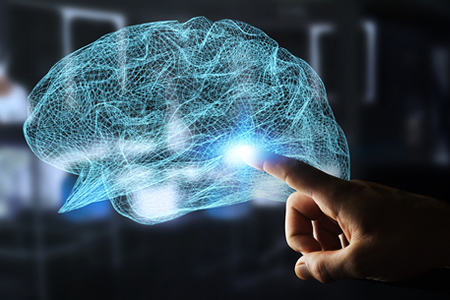Researchers at the University of Maryland, Baltimore County (UMBC) have developed a new technique that improves analyses of patterns of brain activity in patients with mental illnesses such as schizophrenia from fMRI scans. These tools can help with the diagnosis of mental illnesses as well as show when treatments are, or are not, working.
The new technique – named independent vector analysis (IVA) for common subspace extraction (CS) – was developed by Tülay Adali, professor of computer science and electrical engineering/ director of UMBC’s Machine Learning for Signal Processing Lab at UMBC, and Qunfang Long, a Ph.D. candidate in electrical engineering at UMBC.
Using this new technique, Adali and Long were able to categorize subgroups of fMRI data based only on brain activity and were able to identify subgroups of schizophrenia patients from the fMRI scans.
The subgroups of schizophrenia patients identified using the new technique correlated with their diagnostic symptoms and therefore have clinical significance. It was not previously possible to identify different subgroups of schizophrenia patients based solely on neuroimaging data. The research clearly shows that there is a direct correlation between a patient’s brain activity and their diagnosis and symptoms.
“Now that data-driven methods have gained popularity, a big challenge has been capturing the variability for each subject while simultaneously performing analysis on fMRI datasets from a large number of subjects. Now we can perform this analysis effectively, and can identify meaningful groupings of subjects,” said Adali.
Correctly diagnosing patients with mental health problems can be challenging, as different patients with the same condition can have different symptoms. Developing an effective treatment regimen is also challenging and can be a time-consuming trial and error process. Patients with the same condition may not respond to the same treatment and sometimes it is difficult to determine if the treatment is actually working well.
As well as helping to correctly diagnose a patient, the new technique can provide objective evidence if a treatment is working. A patient with schizophrenia can be provided with a treatment and be scheduled for a follow up evaluation in 6 months. The results of the follow up fMRI scan can then be compared with the scans of other untreated patients in the same subgroup and scans of mentally healthy patients who do not have schizophrenia. If the patient’s fMRI scan more closely resembles the fMRI scans of healthy patients rather than patients in the same schizophrenia subgroup, it will show that the treatment is working.
Adali and Long are now working planning to conduct a longitudinal study to determine which treatments are the most effective for different schizophrenia subgroups, as well as evaluating the effectiveness of specific treatments for patients with other mental health illnesses.
You can read more about the study in the paper – Independent vector analysis for common subspace analysis: Application to multi-subject fMRI data yields meaningful subgroups of schizophrenia– which was recently published in the journal NeuroImage. DOI: 10.1016/j.neuroimage.2020.116872
